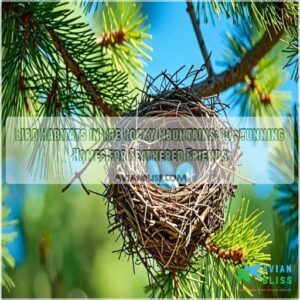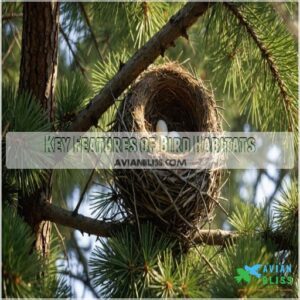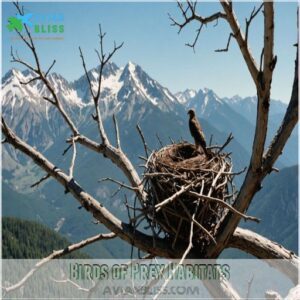This site is supported by our readers. We may earn a commission, at no cost to you, if you purchase through links.

You’ll find hawks soaring over ponderosa pines and vibrant warblers flitting through willow thickets.
The rugged landscapes support majestic eagles, elusive owls, and energetic woodpeckers, each species perfectly adapted to its environment.
These habitats are essential for nesting and feeding, supporting a delicate balance in these ecosystems.
So, whether you’re a birder or simply curious, the Rockies offer an avian adventure that’s both enlightening and important to preserve for future generations.
Table Of Contents
- Key Takeaways
- Bird Habitats Overview
- Diverse Habitats of Rocky Mountains
- Key Features of Bird Habitats
- Types of Bird Habitats
- Birds of Prey Habitats
- Owl Habitats and Characteristics
- Woodpecker Habitats and Adaptations
- Passerine Habitats and Traits
- Importance of Habitat Conservation
- Threats to Bird Habitats in Rocky Mountains
- Frequently Asked Questions (FAQs)
- Where can I find a list of bird species in Rocky Mountain National Park?
- Why is Rocky Mountain National Park a global Important Bird Area?
- What animals live in Rocky Mountain National Park?
- What birds live in the Rocky Mountains?
- What birds live in Colorado?
- What are the most common water birds in Rocky Mountain National Park?
- What are the common habitats for birds?
- What birds of prey live in the Rocky Mountains?
- What is the habitat of the Rocky Mountains?
- How many birds are in the Rocky Mountains?
- What is the best time to observe birds?
- How do birds adapt to seasonal changes?
- Which migratory birds visit the Rocky Mountains?
- How do elevation changes affect bird species?
- Are there guided birdwatching tours available?
- Conclusion
Key Takeaways
- You’ll discover that the Rocky Mountains host over 270 bird species, including the vibrant Mountain Bluebird often found in open spaces like prairies and sagebrush steppe, such as those with blue birds in Colorado, each perfectly adapted to its unique habitat, from aspen groves to alpine tundras.
- Hawks, eagles, and owls thrive in these varied landscapes, showcasing adaptations that help them nest, hunt, and survive in the diverse ecosystems.
- Seasonal changes significantly impact bird populations, with migratory species like warblers and sparrows taking advantage of the Rockies’ rich food sources and habitats.
- Conservation efforts are crucial for preserving these habitats against threats like climate change and habitat loss, ensuring future generations can enjoy these avian wonders.
Bird Habitats Overview
The Rocky Mountains are a bustling avian metropolis, home to over 270 bird species.
You’ll find a diverse array of feathered residents and seasonal visitors, each adapted to specific habitats.
Bird diversity here is astounding, with habitats ranging from lush mountain meadows to dense coniferous forests.
Conservation efforts are essential as habitat changes affect these delicate ecosystems.
Rocky Mountain National Park, designated a Global Important Bird Area, plays a key role in protecting these habitats.
Seasonal variations bring new species, making bird identification an exciting challenge.
Whether you’re a seasoned birder or a curious newcomer, these mountain habitats offer a thrilling glimpse into the lives of our winged neighbors.
Diverse Habitats of Rocky Mountains
You’ll encounter a diverse array of bird habitats as you explore the Rocky Mountains, from aspen groves to alpine tundra.
These varied ecosystems support over 270 bird species, each adapted to thrive in its specific environment.
Aspen
Aspen groves paint the Rocky Mountains with golden hues, offering birds a vibrant sanctuary.
You’ll spot woodpeckers drumming on tree trunks and warblers flitting through rustling leaves.
These open woodlands buzz with insect life, a buffet for hungry birds.
Come fall, the fiery foliage transforms into a spectacular backdrop for wildlife viewing.
It’s a bird watcher’s paradise, where Colorado’s feathered residents thrive amidst nature’s ever-changing canvas.
Ponderosa Pine
Towering Ponderosa pines create a haven for diverse bird species in the Rocky Mountains.
These coniferous forests host a variety of avian residents, from woodpeckers to owls.
You’ll find nesting behavior and bird breeding activities throughout the canopy.
Pine beetle impact and fire ecology shape this habitat, influencing bird migration patterns.
Habitat management efforts focus on preserving these important ecosystems for our feathered friends.
- Listen for the rhythmic tapping of woodpeckers echoing through the forest.
- Watch in awe as owls silently glide between the majestic pines at dusk.
- Feel the thrill of spotting colorful warblers flitting among the branches during migration season.
Willow
Willows’ slender branches create a haven for diverse bird species in the Rockies.
You’ll find these moisture-loving shrubs along streams and wetlands, providing essential habitat for warblers, flycatchers, and sparrows.
Willow ecology supports a rich food web, attracting insects that birds feast on.
Conservation efforts focus on maintaining healthy willow stands, essential for the Colorado Birding Trail.
Birdwatchers flock to these areas, spotting species like the Wilson’s Warbler and Lincoln’s Sparrow in their natural habitat.
Spruce
Spruce forests offer a haven for diverse bird species in the Rocky Mountains.
These evergreen giants provide essential habitats for our feathered friends, and for those interested in learning more, you can explore Spruce forest products inspired by these habitats.
You’ll find:
- Crossbills with specialized beaks for extracting seeds from cones
- Owls nesting in hollows, taking advantage of the dense canopy
- Woodpeckers drumming on trunks, searching for insects
Spruce adaptations make these trees resilient to harsh conditions, supporting a rich ecosystem.
However, climate change threatens these habitats, making conservation efforts important for preserving bird diversity in this unique environment.
Fir
Fir forests offer a cozy retreat for our feathered friends.
You’ll find these evergreens creating dense canopies, perfect for birds seeking shelter.
Their branches provide sturdy platforms for nesting, while the seeds tucked in cones serve as a nutritious food source.
Fir adaptations, like thick bark and flexible branches, guarantee these trees can weather harsh mountain conditions, making them reliable long-term homes for various bird species.
Alpine Tundra
You’ll find the alpine tundra zone above the treeline, where hardy birds face extreme conditions.
Climate change impacts this fragile ecosystem, affecting vegetation adaptations and food availability.
American pikas and white-tailed ptarmigans call this home, braving breeding challenges amidst tundra wildflowers.
The Rocky Mountains are home to various bird species, such as the Black-capped Chickadee’s mountain habitats. As temperatures rise, these alpine tundra birds must adapt or risk losing their unique habitat.
It’s a delicate balance between survival and the changing mountain landscape.
Key Features of Bird Habitats
Bird habitats in the Rocky Mountains offer essential features for survival and reproduction.
These habitats provide food sources, shelter from predators and weather, nesting sites, and access to water, all of which are critical for various bird species to thrive in the diverse ecosystems of the region.
AI In Healthcare
The natural world and technology are merging in unexpected ways.
Just as birds adapt to diverse habitats, AI is reshaping healthcare landscapes.
This powerful tool is transforming patient care, much like how alpine tundra supports unique avian life.
Here’s how AI is nesting in healthcare:
- Diagnoses: AI analyzes medical images with bird-like precision
- Treatment plans: Algorithms tailor care as uniquely as each bird’s nest
- Cost-efficiency: AI streamlines operations, conserving resources like birds in their ecosystems
These advancements promise safer, more accessible healthcare for all.
Ethical AI Considerations
Ethical considerations loom large as AI enters bird habitat research in Rocky Mountain National Park.
You’ll need to address AI bias when analyzing data from the alpine tundra or Trail Ridge Road.
Privacy concerns arise when tracking birds near Old Fall River Road.
Guarantee transparency in AI models used at the Alpine Visitor Center.
Consider the accountability of AI decisions affecting habitat management.
Don’t forget potential job displacement for traditional researchers.
Balancing innovation with ethical practices is key to responsible AI use in conservation.
Machine Learning Applications
Machine learning is revolutionizing bird habitat research in Rocky Mountain National Park.
By crunching vast datasets, AI models predict species distribution with uncanny accuracy.
They’re helping conservationists understand how climate change impacts alpine tundra dwellers like the American pika.
You’ll find these smart systems hard at work along Trail Ridge Road, tracking bighorn sheep movements.
- For bird identification, a field guide like the one found in this bird identification guide helps keep identification skills sharp. AI-powered bird identification apps
- Habitat prediction models using satellite imagery
- Species distribution forecasting for conservation planning
- Automated tracking of migratory patterns
These tools are giving wings to our understanding of avian ecosystems.
Types of Bird Habitats
The Rocky Mountains offer a diverse array of bird habitats, including forests, grasslands, wetlands, and mountainous regions.
Each habitat type provides unique resources and conditions that support different bird species.
From the dense canopies of coniferous forests to the open expanses of alpine meadows, each habitat offers a unique environment for birds.
Forests
Amid Rocky Mountain National Park’s diverse forest types, you’ll find a bustling avian metropolis.
Coniferous and deciduous trees create multi-layered canopies, offering prime real estate for various bird species.
From the chattering of chickadees in ponderosa pines to the haunting calls of owls in spruce-fir forests, each layer tells a unique story.
While forest fires and logging impact these habitats, conservation efforts aim to preserve this vital ecosystem for future feathered generations.
Grasslands
While forests teem with life, the grasslands offer a different kind of haven.
You’ll find grassland birds adapting to wide-open spaces, nesting right on the ground.
At Pawnee National Grassland, seasonal changes bring new challenges.
Fire ecology plays a key role, shaping the landscape.
Chico Basin Ranch showcases how grazing elk contribute to habitat diversity.
Conservation efforts focus on combating nitrogen deposition and protecting these important ecosystems, ensuring grassland birds have a home for generations to come.
Wetlands
Wetlands in the Rockies are bustling hubs for diverse waterfowl.
You’ll find these water-rich havens teeming with life at spots like Barr Lake and Cherry Creek State Parks.
These areas support a variety of wetland birds, from elegant herons to playful ducks.
Conservation efforts are essential, as invasive species pose threats.
For prime wildlife viewing, visit Fountain Creek Regional Park or explore Cottonwood Canyon’s hidden wetland gems.
Mountainous Regions
Mountainous regions in Colorado’s Rocky Mountains offer a unique paradise for birds.
As you climb higher, you’ll notice the dramatic changes in vegetation and wildlife, which is why creating bird-friendly habitats in these areas is essential, and you can find products to support this at Colorado Bird Habitats.
The alpine tundra, with its harsh microclimate, presents challenges that birds overcome with remarkable adaptations.
Despite the cold and wind, these high-elevation habitats provide refuge for species like the White-tailed Ptarmigan.
You’ll be amazed at how these feathered mountaineers thrive in such extreme conditions.
Birds of Prey Habitats
You’ll find diverse habitats for birds of prey in the Rocky Mountains, including eagles, hawks, ospreys, falcons, kestrels, and vultures.
These raptors thrive in the park’s varied landscapes, from soaring cliffs to dense forests, where they hunt and nest using their specialized adaptations.
Eagles
Majestic eagles soar above Colorado’s alpine tundra, their keen eyes scanning for prey.
You’ll spot these raptors nesting on rocky cliffs or tall trees.
Their diet includes fish and small mammals.
During eagle migration, they travel long distances to find suitable habitats.
Conservation efforts focus on protecting nesting sites and reducing human disturbances.
You can contribute to eagle conservation through citizen science programs, helping track populations and monitor nesting success.
Hawks
While eagles reign supreme, hawks carve out their own niche in the Rockies.
You’ll spot these skilled hunters soaring over diverse terrains, from dense forests to open meadows.
Their adaptability is key to their success.
Here’s what makes hawks thrive in Colorado’s alpine tundra:
- Nest on rocky outcrops for panoramic views
- Hunt small mammals scurrying among cushion plants
- Use thermal updrafts for effortless migration
- Camouflage against lichen-covered rocks
- Benefit from permafrost-preserved prey in summer
Ospreys
Soaring above Colorado’s wildlife refuges, ospreys captivate with their impressive fishing techniques.
You’ll spot these raptors near lakes and rivers, where they dive for fish with laser-like precision.
Their diet consists almost entirely of fish, which they snatch with specialized talons.
Ospreys build massive stick nests on platforms or tall structures, often returning to the same site yearly.
During scenic drives through Colorado National Monument, keep an eye out for these magnificent birds of prey.
Falcons
Falcons, the aerial acrobats of the Rockies, command the skies with unmatched precision.
These swift hunters have adapted to thrive in Colorado’s diverse landscapes.
You’ll find them nesting on cliff faces and hunting over open areas, often in natural cliff habitats and urban environments.
Their incredible speed and agility make them formidable predators, perfectly suited for life in the mountains.
- Peregrine falcons can dive at speeds over 200 mph
- Prairie falcons prefer more arid habitats in the foothills
- Falcon migration routes often follow mountain ranges
- Conservation efforts have helped falcon populations rebound
- Front Range Pika Project monitors falcons’ alpine prey species
Kestrels
Kestrels, the smallest falcons in North America, thrive in the Rocky Mountains’ open spaces.
You’ll spot these agile hunters hovering over fields, scanning for prey.
Kestrel adaptations include keen eyesight and the ability to see ultraviolet light, helping them track rodents.
Their diet consists mainly of insects and small mammals.
For nesting, kestrels prefer tree cavities or cliffs.
The protection of bluebirds in Pennsylvania, where they have faced challenges such as habitat loss and DDT, highlights the importance of conservation efforts. Conservation efforts focus on providing nest boxes to support these charismatic birds.
Learn to identify kestrels by their rusty-red backs and distinctive facial markings.
Vultures
Unlike their smaller cousins, vultures prefer open areas with sparse vegetation.
These scavengers play a key role in the ecosystem.
You’ll often spot them:
- Circling high above, riding thermals with impressive wingspans
- Perched on rocky outcrops, scanning for carrion
- Gathered in groups, sharing communal roosts
Their unique diet of carrion requires strong stomach acid to break down potentially harmful bacteria.
Vultures and woodpeckers often coexist in the same Rocky Mountains ecosystems, where woodpeckers control insects. Vultures’ migration patterns and social behavior are fascinating subjects of ongoing conservation efforts in the Rockies.
Owl Habitats and Characteristics
You’ll find three owl species in the Rocky Mountains: the Great Horned Owl, Northern Pygmy-Owl, and Boreal Owl.
These nocturnal hunters have specialized adaptations, including large eyes for excellent night vision and silent flight feathers for stealthy predation.
Great Horned Owl
The phantom of the forest, the Great Horned Owl, thrives in Rocky Mountain woodlands.
You’ll find these nocturnal hunters perched in dense trees, their haunting hoots echoing through the night.
They’re adaptable, nesting in old hawk or squirrel nests, or even utilizing specially designed Great Horned Owl habitats.
Their diet’s diverse, from small mammals to birds.
Conservation efforts focus on preserving their habitats.
With powerful talons and silent flight, they’re master predators.
Listen for their distinctive "hoo-h’ooh" call – nature’s own nighttime symphony in the Rockies.
Northern Pygmy-Owl
Wondering where the Northern Pygmy-Owl hangs out?
These small, yet mighty owls favor the Rocky Mountains, residing mostly in mixed fir forests ranging from river bottoms to timberline.
Adapting well to both coniferous and deciduous landscapes, these feathered hunters have honed their skills in prey selection, targeting small birds, mammals, and insects.
Their active lifestyle, both day and night, underscores their adaptable, efficient hunting habits.
Boreal Owl
Because they’re masters of camouflage, you might miss spotting a Boreal owl.
Their range includes northern forests, and their diet consists mainly of small mammals.
You’ll find them nesting in tree cavities, often in dense coniferous forests of spruce, aspen, poplar, birch, and fir, which provide them with cover and ambush sites, learn more about their boreal owl habitats.
- Boreal owl vocalizations are distinctive, low-pitched hoots.
- Their conservation status is relatively stable, but habitat loss is a concern.
- Learning about their unique characteristics helps with Boreal owl conservation efforts.
Woodpecker Habitats and Adaptations
In the Rocky Mountains, woodpeckers like the American Three-toed and Northern Flicker adapt by using strong, chisel-shaped bills to drill into trees for insects.
Their zygodactyl feet, with two toes facing forward and two backward, help them cling to vertical trunks.
Stiff tail feathers provide support during pecking.
American Three-toed Woodpecker
As owls silently glide through the night, turn your gaze to the American Three-toed Woodpecker’s daytime antics.
Thriving in burnt forests, this woodpecker’s habitat offers rich pickings, with insects fitting their diet precisely.
Nesting in dead trees, they avoid threats but face conservation challenges.
Adaptations like zygodactyl feet and chisel-like bills highlight nature’s artistry in survival skills.
Hairy Woodpecker
The American Three-toed Woodpecker might’ve you marveling at its subtle majesty, yet the Hairy Woodpecker offers its own charm.
Resilient and resourceful, this bird’s diet spans insects pecked from tree trunks.
The sounds of nature, including woodpeckers in Alaska’s coniferous forests, can be particularly telling. Listen for woodpecker drumming—a rhythmic dance marking territory and nesting behavior.
Protecting their habitats helps ensure continued delight throughout their woodpecker range in the Rocky Mountain landscapes.
Williamson’s Sapsucker
Imagine a majestic sapsucker, tapping its way through the Rocky Mountains.
Understanding Williamson’s Sapsucker is key to appreciating bird diversity here.
You’ll discover:
- Diet: Mainly sap and insects.
- Nesting habits: Cavity nesters.
- Migration patterns: Partial migrants.
- Conservation efforts: Focus on habitat preservation.
- Vocalizations: Distinct drumming sounds.
This sapsucker thrives in diverse forest habitats.
Northern Flicker
Shifting from Williamson’s Sapsucker, you’ll meet the Northern Flicker, a lively woodpecker found across a vast range.
Noted for its distinct calls, it nests in tree cavities.
Its diet primarily consists of ants and beetles.
Conservation efforts help maintain their vibrant presence in our ecosystems, offering both beauty and ecological balance in the Rocky Mountains.
Passerine Habitats and Traits
You’ll find passerines in Rocky Mountain’s diverse habitats, each with unique traits suited for survival. From sparrows to swallows, these birds showcase varied bill shapes and vibrant plumage.
Sparrows
Throughout the year, you’ll find sparrows thriving in diverse Rocky Mountain habitats. Their diet consists mainly of seeds and insects. Listen closely for their simple, yet charming songs!
Sparrow nesting involves building cup-shaped nests in shrubs or on the ground.
Sadly, habitat loss threatens sparrow populations; sparrow conservation efforts are vital.
Understanding sparrow migration patterns helps us protect these resilient birds.
Finches
From watching sparrows, let’s consider finches.
Their habitats offer unique insights into finch migration patterns and vibrant finch songs.
These small, lively birds adapt well to various environments.
Imagine this:
- Finch Diet: Seeds and insects.
- Finch Nesting Habits: Intricate, woven nests.
- Finch Conservation: Efforts to protect populations.
- Finch Migration Patterns: Seasonal journeys for food.
Wrens
A wren’s song is like nature’s cheerful alarm clock, echoing through Rocky Mountain mornings.
These tiny avian architects craft elaborate nests tucked into shrubs, showcasing their lively behavior.
Understanding wren conservation helps maintain balance in these vibrant ecosystems.
Keep an ear out for Rocky Mountain wrens, and you’ll appreciate the freedom they embody in their spirited lifestyles.
Dippers
Wrens might serenade you with complex tunes, while dippers charm through perky, aquatic antics.
Nestled along rushing streams, these sturdy birds are dressed in slate-gray.
Dipper adaptations include specialized eyelids, enabling them to thrive underwater, catching insects.
Their natural habitats, like mountain streams and Pacific Northwest shores, are essential for their survival.
Observing their behavior can feel like watching a tiny, determined submarine.
Explore their range for insight into dipper conservation and contribute to maintaining their unique habitats.
Thrushes
Thrushes often enchant with their melodic songs, varying greatly amongst species.
Their migration patterns lead them through the Rockies, where they find ample diet options like insects and berries.
Nesting habits include building tidy cups in dense foliage for safety.
Conservation efforts aim to protect these passageways and habitats, ensuring that thrushes continue to thrive and sing their joyous tunes.
Warblers
Consider warblers, these tiny, energetic birds flit around, dazzling you with their vibrant plumage.
- Migration: Warblers set out on long journeys, a marvel of endurance.
- Songs: Their melodic tunes fill forests, a distinct identifier.
- Diet: Consists mainly of insects, contributing to pest control.
- Conservation: Protecting their habitats guarantees future melodies.
Crows
Ever notice crows around the Rocky Mountains?
These clever birds thrive thanks to their remarkable intelligence and adaptability.
Crows communicate using a complex mix of sounds, showcasing behavior that’s both intriguing and insightful.
Their diet is remarkably varied, from insects to grains.
Adaptations like acute problem-solving skills make them successful in diverse habitats, underscoring their fascinating survival strategies.
Jays
Observing Jays in their mountain habitat reveals much about their unique characteristics.
You’ll find their distinctive Jay vocalizations echoing through the pines.
Their diet consists of nuts, seeds, and insects, showcasing adaptability.
Jay behavior includes caching food for later, a clever survival strategy.
While not strong migrators, Jay conservation efforts focus on protecting their woodland homes.
Understanding these aspects helps appreciate these intelligent birds.
Swallows
Imagine swallows darting gracefully through the sky, their agile flight a key to survival.
You’ll find them building mud nests under cliffs, a strategy to evade predators.
Their diet? Insect-heavy, catching bugs mid-air.
Listen for their cheerful songs heralding seasonal migrations.
Yet, swallows face threats like habitat loss, pushing their survival needs to the brink.
Importance of Habitat Conservation
Habitat conservation isn’t just about protecting pretty landscapes; it’s essential for preserving bird and biodiversity equilibrium.
A balanced ecosystem supports avian life, offering them safe havens free from habitat loss.
By reducing hazards such as window collisions, as seen in efforts to protect birds, we can make a significant difference.
Consider these essential points:
- Climate change alters habitats, impacting bird populations.
- Sustainable tourism can help by reducing human footprints.
- Invasive species disrupt native flora and fauna.
- Conservation efforts guarantee diverse habitats remain for future generations.
When you see a thriving forest or meadow, know your efforts in conservation make a tangible difference.
Threats to Bird Habitats in Rocky Mountains
In the Rocky Mountains, bird habitats face various challenges, many of which might worry you.
Climate change disrupts seasonal patterns and affects the availability of food.
The region’s unique habitats, including high-elevation willow and evergreens, are particularly vulnerable to these changes, as home to over 280 bird species in the Rocky Mountain Birds.
You’d find habitat loss troubling, as urban sprawl and deforestation shrink areas for nesting and feeding.
Invasive species like non-native plants and animals often outcompete natives, altering the ecological balance.
Pollution, especially from plastics and chemicals, poses a direct threat.
In addition, human activities such as hiking and off-road vehicles can inadvertently disturb these vital environments.
Frequently Asked Questions (FAQs)
Where can I find a list of bird species in Rocky Mountain National Park?
You’ll find a thorough list of Rocky Mountain National Park bird species on the IRMA Portal NPSpecies site. It’s a great resource for bird enthusiasts!
Why is Rocky Mountain National Park a global Important Bird Area?
Imagine counting over 270 bird species in one spot.
Rocky Mountain National Park earned its Global Important Bird Area title for its rich biodiversity, offering a key sanctuary for both migratory and resident birds.
What animals live in Rocky Mountain National Park?
Rocky Mountain National Park hosts elk, black bears, coyotes, moose, and bighorn sheep.
You might see marmots and pikas among rocks.
The park offers diverse habitats for these mammals, creating a thriving ecosystem in stunning landscapes.
What birds live in the Rocky Mountains?
Feathers flutter like confetti in the breeze as you explore the Rocky Mountains, inhabited by over 270 bird species.
From the majestic eagles and owls to lively sparrows, diverse habitats support a rich avian tapestry.
What birds live in Colorado?
Colorado’s diverse ecosystems host a wide range of birds.
You’ll find majestic bald eagles, busy woodpeckers, agile hummingbirds, and vibrant passerines like warblers and finches.
Each species thrives within Colorado’s unique landscapes, offering an extraordinary birdwatching experience.
What are the most common water birds in Rocky Mountain National Park?
You might spot common water birds like mallards, Canada geese, and great blue herons in Rocky Mountain National Park.
These birds frequent the park’s lakes, ponds, and streams, offering unique sights for birdwatchers and nature lovers.
What are the common habitats for birds?
Imagine a bustling city where each neighborhood offers unique charms; bird habitats mirror this diversity.
Birds thrive in forests, wetlands, grasslands, and urban areas.
These spaces provide essential food, shelter, and breeding grounds, supporting varied avian life.
What birds of prey live in the Rocky Mountains?
Rocky Mountain birds of prey include eagles, hawks, and falcons. They’re masterful hunters, with keen eyesight and powerful talons. Their diverse habitats provide ample hunting grounds.
What is the habitat of the Rocky Mountains?
Explore the Rocky Mountains’ diverse habitats, including lush aspen groves, towering ponderosa pines, and alpine tundra.
Each environment supports unique wildlife, providing a perfect backdrop for adventurous hikes and a haven for nature enthusiasts seeking tranquility.
How many birds are in the Rocky Mountains?
Counting the countless, you’ll find over 270 bird species have been documented in the Rocky Mountains.
This diverse avian assembly includes year-round residents and migratory birds, thanks to the region’s rich range of habitats.
What is the best time to observe birds?
The best time to observe birds is early morning or late afternoon, as many species are more active then.
Dawn chorus provides a delightful performance, and you’ll catch them feeding, singing, and engaging in their natural behaviors.
How do birds adapt to seasonal changes?
Like a well-tuned orchestra responding to nature’s cues, birds adjust by migrating to warmer regions, altering diets, and changing plumage for camouflage.
Birds conserve energy by flocking, and shifting nesting patterns to suit shorter days.
Which migratory birds visit the Rocky Mountains?
Many migratory birds visit the Rocky Mountains, including warblers, sparrows, and swallows.
These species travel seasonally, taking advantage of rich food sources and diverse habitats like forests and tundra.
Migratory birds ensure a successful breeding period each year.
How do elevation changes affect bird species?
Elevation impacts avian adaptability, altering altitude.
Each level nurtures unique needs, from oxygen changes to temperature swings.
Birds benefit by selecting sites snuggled comfortably in their climate niche, enhancing survival and choosing to thrive where they’re best suited.
Are there guided birdwatching tours available?
You’ll want to check the park’s official website or contact the visitor center. They’ll have the most up-to-date information on guided birdwatching tours and availability.
Conclusion
Imagine a hiker spotting eagles in the aspens as a metaphor for the diverse bird habitats in the Rocky Mountains.
This stunning mosaic—ranging from dense forests to stark alpine tundras—grasps the delicate ecosystems that feathered species call home.
These habitats balance diversity, supporting majestic eagles to subtle warblers, highlighting the need for conservation.
Understanding bird habitats in the Rocky Mountains helps you appreciate their beauty, encouraging efforts to preserve these important ecosystems for future generations.


















